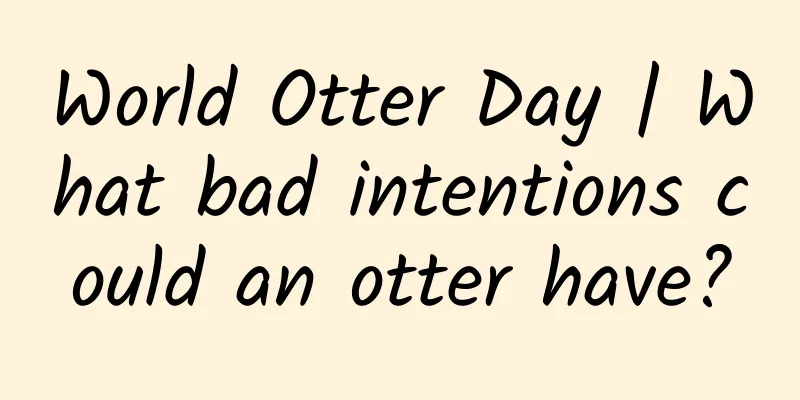World Otter Day | What bad intentions could an otter have?

|
The otters are active! For those who already have children, Take the kids to "develop"? Oh moo! Are the plants okay? As summer approaches quietly and the temperature gradually rises, the otters usher in their most active time; the plants also begin the rhythm of life in the changes of the sun and rain. On this sunny day, the otters of the Banna family became more energetic and their desire to explore was unprecedentedly high, but their frequent activities were always accompanied by "some animals getting injured." "Otter" develops and nurses "maintain" In the outdoor exhibition area of Banna Family, the banana trees that have been dormant for the whole winter can no longer resist the call of the season and shyly poke out new green leaves. However, this vibrant scene hides a trace of mischief - a few fragile leaves are accidentally broken and scattered on the ground, which is obviously the "masterpiece" of a little guy, or a group of little guys who can't sit still. The cub who picked banana leaves It was thought that the banana trees this spring would not be able to escape the vitality of the Banna family, but they showed amazing recovery ability and tenacious vitality. Even in the face of the otters' "special care", they still grew vigorously, getting taller day by day, and their leaves became wider and greener. Thank you for not deceiving me "Some are happy, some are sad." In comparison, the newly arrived palm seedlings were not so lucky. They were meant to enrich the otter's home environment, but unexpectedly became the newest playground for the little otters. The otter father Cha Cha was the first to ride on the still very thin stems, swinging his tail and rubbing them, and began to mark them, as if he had conquered a miniature "palm mountain". Hide quickly! Don't be caught doing "bad things" Seeing this, the little otters naturally did not want to be left behind, and followed their father Cha Cha's example, and a series of "palm tagging competitions" began. Poor palm seedlings, how could their tender bodies withstand such "kindness"? Gradually, the leaves lost their former luster, revealing some signs of being powerless. After experiencing the previous small "crisis" of plants, the keepers decided to introduce a new member - a heather tree, which quickly attracted the attention of the otters and became their new exploration object. Cha Cha still used his talent as a "plant pruning master" and occasionally "personalized pruning" the tree, and the little otters followed closely, climbing up and down, chewing the leaves a few times, and learned new skills of climbing and tasting leaves. Banna Cha Cha would also collect these branches and hold them in his mouth to make nests. A Banna Family in a Nest However, the good news is that this heather tree has shown amazing adaptability and resilience. Faced with the "enthusiastic interaction" of the otters, it did not repeat the mistakes of the palm seedlings. After a period of observation, this heather tree should have survived the most dangerous stage. The "stealing feeling" is a bit strong Compared with the palm trees next to the Banna family, the lush rose bush to the right of the Lancang Weng Weng family is particularly eye-catching. Several roses planted in the Lancang residential area have now broken through the soil, and the banana trees accompanying them have also regained vitality, apparently thanks to the sharp thorns on the rose branches, which have built a natural protective barrier for them. The living environment of the Lancang family This provides ideas for the landscape planning of the exhibition area: through scientific planting, we can not only beautify the environment, but also cleverly guide animal activities, achieving a win-win situation for biodiversity and environmental protection. How to give plants opportunities to grow while animals express their natural behaviors is a topic that needs to be explored further. Sunny afternoon "Otter" time Recently, as the afternoon sun has become gentler, it has become easier for uncles and aunts to witness the daily life of otters. The Banna family will make full use of this beautiful time and enjoy a leisurely "sunbathing" together in the outdoor field. The scene is warm and interesting. A family in Banna takes a nap together This light is so beautiful They might snuggle together, or scatter to climb and dig here and there, or run around behind their mother Banna to take care of their own little nests, or take a nap alone in a shady tree hole. The cub runs around behind his mother Banna Are they learning the skill of nesting? Or they happily forage for food and play in the water; shrimps, fish, crustaceans and mollusks are their favorites. The crystal clear shrimps are enjoying the sunshine. Out of the water "Otter" During this golden season, Lan Cang seemed to particularly enjoy the quietness of the morning and began to move around in his territory early. He sniffed the grass mat under the glass window, picked up a mouthful, and ran home to make a nest. Early morning activities In contrast, Hung Hung seems to be more lazy, always a beat slower than Lancang to start her day. After getting up, she would choose to sniff around on the naturally fallen wood by the water. Another day of envying the otter Too cute to be a crime, Otters need to be protected In order to raise public awareness of otters and the threats they face, the International Otter Survival Fund proposed in 2014 that the last Wednesday of May be established as World Otter Day. This year is the tenth World Otter Day! There are three species of otters in my country, namely the Eurasian otter, the Asian small-clawed otter and the smooth-coated otter. They are the top predators of freshwater ecosystems and the "monitors" of wetland ecosystems, and are very sensitive to habitat destruction and pollution. Living in the native species conservation area of Hongshan is a group of Asian small-clawed otters! Make no mistake! We are Asian small-clawed otters! But nowadays, the lazy otters also have troubles in their lives: vegetation destruction and water pollution have caused their homes to become smaller, food to become scarce... ultimately leading to the shrinkage of the otter population. Indeed, otters can easily capture people's hearts with their cute appearance, but their real life is much harder than we imagine. Behind the joy and healing they bring us, there are hidden threats such as deteriorating living environment and habitat loss. The decline in the number of otter populations often means a decline in freshwater quality, so when we protect otters, we are not only protecting otters as a species, but also the freshwater resources on which we depend for survival. Protecting the otter starts with you and me! More love, more protection! |
>>: Attention! Many people suffer from this habit that hurts their knees!
Recommend
How to solve the low conversion rate? Here are 5 tips!
The operational goal of our service account is to...
After Jawbone’s collapse, will domestic smart bracelets also be eliminated?
A few years ago, many people would ask: What is t...
Children's Day poster collection
To be honest, This issue of the Children's Da...
Note to developers: Android M's permission mechanism
Introduction Before the release of Android M, the...
Wonder! The sky appeared strange green. What is the reason?
Earlier, a severe storm swept through Sioux Falls...
Rare! New discovery in the universe
"Misty Binary Stars": Two rare star sys...
Why is the sound of the piano so beautiful? It’s inseparable from these four major instruments!
When it comes to the piano, many students who hav...
Zhang Chaoyang: TV series are still the "staple food" of Sohu Video
January 30 (Reporter Zhang Zhichang) After the fu...
WhatsApp tests new feature: transfer chat history between iPhone and Android
WhatsApp is testing a new feature that allows use...
The Ice Bucket Game is becoming increasingly alien to charity
The "Ice Bucket Challenge" to raise awa...
The fastest way to earn $500,000 a month? Apple App Store becomes a hotbed for scam software
Recently, foreign technology writer Johnny Lin pu...
The delicious but hard to peel Torreya grandis finally "opened"!
In the past two days, at the Torreya grandis plan...
The most popular functional responsive programming library on GitHub: ReactiveCocoa and RxSwift framework comparison
1. Introduction Functional Responsive Programming...
Tesla's Evolution: Battery Density Increased 30% from First Car to Model 3
So far, we still don't know the battery speci...
How does China's non-invasive brain-computer interface technology achieve "mind typing"?
In May 2023, there was a piece of news that many ...









